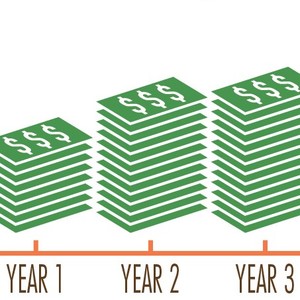Nurses save lives. They practice in a variety of traditional healthcare settings, and classifications of nurses earn different salaries. On average, nursing salaries in the United States are 7% higher than the average job salary nationwide. In fact, the Bureau of Labor Statistics projects that nursing will be among the ten fastest growing occupations of the next decade. For people who want a good-paying, stable nursing job, one class stands in the way: Anatomy and Physiology. Listen to learn how one technical college adapted its nursing program to increase its rate of student success.
Listen to the story
MELISSA BLOCK: Lots of college students heading back to school this week plan to go into the healthcare industry when they graduate. The pay is good. The field is growing. But anyone who wants one of these jobs has to make it through introduction to anatomy and physiology their freshman year, and it’s tough. Zoe Chace from our Planet Money team has the story of one student taking it on.
ZOE CHACE: It’s the first day of anatomy and physiology one at West Kentucky Community and Technical College. Instructor goes over the syllabus, the office hours, then moves right into the material which is pretty dense.
UNIDENTIFIED MAN: The humerus is the long bone found in the arm. Is this anatomy, or is this a physiological description?
CHACE: There’s a guy in the front row taking notes. He’s got safety goggles pushed up on his head – turns out he came straight from work.
Are you new to this stuff?
JONATHAN HARNED: Pretty much. Very new.
CHACE: How is it?
HARNED: It’s a lot all at once.
CHACE: His name is Jonathan Harned. He puts up billboard advertisements for a living. He’s 40 years old, got a military crew cut – he’s wearing an American flag T-shirt.
Can you tell me what you are doing here?
HARNED: I want to be a nurse.
CHACE: Jonathan was the first one here. He was an hour and a half early. Now, Jonathan has spent 20 years building up to this moment. This is big.
And what did you think you were going to do when you grew up?
HARNED: I was going to get a job like my dad at some big factory or something and just stay there for 30 years and retire.
CHACE: Instead, he’s had lots of jobs. And he punctuates each chapter with how much money he made at every stop. After he got back from the Marines, he tried a few things. Mechanic…
HARNED: Eight bucks an hour.
CHACE: Concrete finisher.
HARNED: 15 an hour – something like that.
CHACE: He drove a garbage truck.
Like a sanitation truck?
HARNED: Yes. The ones that pick up the big dumpsters.
CHACE: How was that?
HARNED: I got fat. I’m just sitting in a truck all day. I gained 25 pounds.
CHACE: He lost that job. Then he answered an ad in the paper for $12 an hour. He started putting up billboard ads 10 years ago.
HARNED: I make $17.61 an hour right now. In February I’ll make over 18. And if I lose this job for any given reason, I’m back to 10 – $12 an hour. I have no security. I’ve had 22 years of reasons why I want to be here.
CHACE: Sitting in this anatomy class at community college, stakes are pretty high for everybody. People who finish a nursing program like this one have a much better chance of getting a job. And around here, healthcare jobs pay better. If you can get through this class and get this degree, it can be a magic key to a $19 an hour starting salary. Thing is, it’s hard to get through even the first class. Jonathan’s class is three hours long and lecturey. There’s a ton of reading, and he hasn’t been in school in 25 years.
HARNED: I didn’t know how to study. I don’t read.
CHACE: Hasn’t taken a science class in that long.
HARNED: Chemistry – I can’t do it.
CHACE: There’s some chemistry in here you know?
HARNED: Then I’ll mess it up.
CHACE: In fact, according to a national association, only 50 percent of people make it through this class. Unfortunately, it’s required. I double checked with the dean, Karen Hlinka.
Is there anyway around this class if you want to be a nurse?
KAREN HLINKA: No.
CHACE: Do people try to get around it?
HLINKA: No. (Laughter). There’s no way around. And there’s a reason for that. You’re not taking this class as just an elective. You’re taking this class because it’s building the foundation for the rest of your education. So you’ve got to get it.
CHACE: Lots of people don’t. She’s seen people taking the class again and again.
HLINKA: Four, five, six – on their seventh try. It was frustrating.
CHACE: Hlinka realized that a lot of her students just weren’t ready. They knew how to memorize, but they didn’t really know how to think. Jonathan’s not insulted by that idea. He’s like, yeah, that’s my problem.
HARNED: Well, I thought it was a lot of memorization. And then we get in here in class, and he’s talking about just implied answers. How do you know what the answer is if it’s not in the book?
CHACE: The school set up a special class to slow down the material. And teachers, rather than just assigning the reading, are spending time teaching their students how to read the book. This seems to be helping. Instead of the national is 50 percent average, here about 70 percent of the students make it through the class – not everyone by a long shot, but still, one of the highest rates in the country.
Jonathan thinks he’ll make an A or B in the class. He took a math pre-req over the summer, re-taught himself algebra, got a 96. If he makes it all the way through, he’ll be the first in his family to earn a degree beyond high school. Zoe Chace, NPR News.
 © 2014 National Public Radio, Inc. Used with the permission of NPR. All rights reserved.
© 2014 National Public Radio, Inc. Used with the permission of NPR. All rights reserved. Vocabulary
- anatomy – the branch of science concerned with the bodily structure of living organisms
- community college – a nonresidential junior college offering courses and two-year programs to people living in a particular area
- elective – an optional, not compulsory, course of study
- implied – not stated directly
- physiology – the branch of biology that deals with the normal functions and activities of life or living matter (such as organs, tissues, or cells)
- syllabus – an outline of the subjects in a course of study
Listening Comprehension Questions
- What are some reasons people may want to get a degree in nursing?
- Why does Jonathan Harned want to become a nurse?
- Why is Introduction to Anatomy and Physiology not an elective course?
- Why do about half of nursing students nationwide not pass Introduction to Anatomy and Physiology?
- What was changed and why did this approach work?
Discussion Themes
- After listening to this story, what factors do you think go into raising your income? How difficult or easy do you think it is to do?
- In your opinion, is a nurse’s starting salary a sufficient motivator for a student to complete a nursing program? Why or why not?
Teacher’s Guide
Activate student knowledge: Open class by asking students to think about jobs they have had and the hourly rate they earned. Discuss ways to increase income, like taking continuing education courses in a chosen field, taking on a second job, or changing careers. Invite students to consider the investment of time, money, and effort needed to take courses to start a new career and to weigh them against the potential for salary growth.
Introduce the story: In this story, nursing student Jonathan Harned is attending the first session of Introduction to Anatomy and Physiology, a challenging course all nursing students must pass. Harned reflects on his past hourly jobs and shares his motivation for becoming a nurse. Listen to hear the challenges of aspiring nurses, what they are doing to increase their income, and what one administrator did to increase student success.
Active listening supports: Choose one of the following listening organizers to support student understanding as they listen to the story.
- The Problem and Solution Chart will guide student listening as they takes notes on Jonathan Harned’s reflections on hourly jobs and classroom challenges for new nursing students.
- The Language Identification organizer allows students to follow along and track important phrases while listening to the story.
Paired Text: Use this 2017 article by Karen Angelo, Faculty Teaching Methods Raise the Grade, to pair with this audio story. Have students compare and contrast examples in the article and the audio story of how professors can help nursing students grasp tough concepts to enable student success in nursing classes.
Reflect on the story: Take time for student reflection on the audio story and discussion questions to check for understanding.


